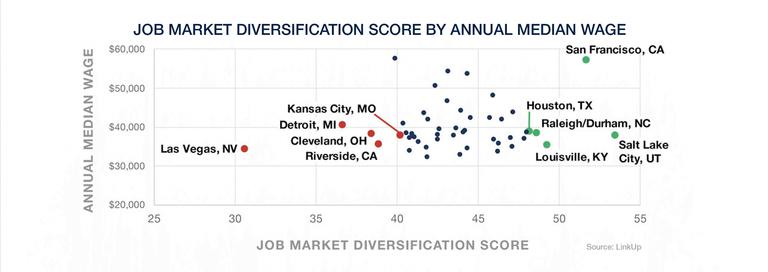Job Market Diversification and Wage
To measure the health of the job market, we need to consider multiple factors, including unemployment rate, labor force participation, and wage growth. The newest measurement is LinkUp’s Job Market Diversification score.

The health of a job market is best measured by considering multiple factors, including unemployment rate, labor force participation rate, wage growth, and more. New to this list of measures is LinkUp’s Job Market Diversification score, a figure assessing market resilience using LinkUp’s extensive job market data and exclusive statistical methodology.
Since 2017, LinkUp has published quarterly Job Market Diversification Reports assessing the 150 largest Metropolitan Statistical Areas (MSAs) in the U.S. In its Q2 2018 report, released August 2, LinkUp found the most diversified cities in each market to be:
- Large Markets: Salt Lake City, UT (Diversification Score: 53.5)
- Mid Markets: Provo-Orem, UT (Diversification Score: 54.9)
- Small Markets: Santa Barbara, CA (Diversification Score: 53)
This quarter, LinkUp also compared Job Market Diversification scores to each city’s median annual wage based on the Occupational Employment Statistics (OES) Survey released in May 2017 by the Department of Labor’s Bureau of Labor Statistics.
An interesting relationship emerged between Job Market Diversification score and median wage in all three market sizes. LinkUp found that the average median wage for the five most diversified cities to be larger that than of the five lease diversified cities in all markets.

In large markets, the average annual wage for the top five most diversified cities was $41,592, but for the five least diversified cities in large markets it is $37,418, a difference of $4,200. For mid markets the most diversified cities average median wage to be roughly $1,000 more, and for small markets roughly $2,500 more. The cost of living was not taken into account, and more analysis is needed to determine the causes of this correlation, but it seems logical that markets with a greater variety of industries, job types and companies would offer more competitive wages. This suggests that not only are diversified job markets more resilient to downturns; they are also more attractive to job seekers in periods of stability.
To learn more about Q2 results, download the report and data or visit the report archive for past reports.
Insights: Related insights and resources
-
Blog
06.21.2018
Job Market Diversification Correlates with Productivity, Education Levels, and Real Estate Activity
Read full article -
Blog
05.09.2018
What Causes High Unemployment Rates?
Read full article -
Blog
02.21.2018
Who will survive Amazon's next HQ2 elimination round?
Read full article
Stay Informed: Get monthly job market insights delivered right to your inbox.
Thank you for your message!
The LinkUp team will be in touch shortly.
